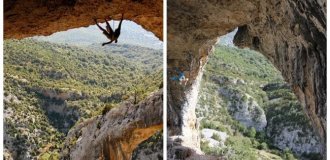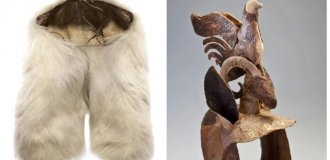Most river mammals spend only part of their lives in water. Animals such as the river otter and the swimming rat live on land and venture into the water in search of food.


1. Hippopotamus.
A hippopotamus peers out of an algae-covered lake in Kenya's Masai Mara Game Reserve. These massive mammals cool their huge bodies in African lakes, ponds and rivers for up to 16 hours a day every day. And although these animals can hold their breath for about half an hour, they usually do not submerge completely under water, leaving the top of their heads on the surface. At night, hippos leave the water and come to land in search of food. If they stay on land too long during a hot day, the animals quickly become dehydrated.

2. Hippopotamus.
The Zambian hippopotamus sends an aggressive message by displaying its sharp teeth, which can reach lengths of 20 inches (51 centimeters). Males use a wide open mouth when fighting to determine which animal is dominant. Sometimes a simple show of force is not enough, and such behavior leads to potentially deadly battles. Hippos are also dangerous to humans.

3. Manatee.
Manatees swim slowly through shallow, warm coastal waters and rivers. For example, such as this crystal clear river in Florida - Crystal River, which is shown in this photo. The large mammals (up to 1,300 pounds or 600 kg) are born underwater and remain there throughout their lives, although they must come up for air every few minutes. Known as sea cows, they are voracious herbivores, feeding on a variety of sea grasses, weeds and algae.
Several different species of manatees live along the Atlantic coast of North and South America, the west coast of Africa, and in the Amazon River.

4. Muskrat.
Muskrats are frequent inhabitants of wetlands, swamps and ponds, where they make their burrows by digging tunnels in marshy banks. This large rodent has a foot-long body and a flat tail almost as long as its body. Muskrats are well adapted to water and begin to swim 10 days after birth. Perhaps best known for their highly developed communication skills, muskrats exchange information with each other and ward off predators with their distinct scent.

5. Baikal seals.
There are a large number of seals living in the world, but only one species is truly freshwater - the Baikal seal. These seals live in the lake of the same name on the territory of the Russian Federation, which is the deepest in the world. Although new generations of Baikal seals are born every year in such colonies, this species is not in serious danger. The main threats are poaching, as well as pollution from paper and pulp production, which are located near the lake.

6. Amazonian dolphin.
To track food (small fish and crustaceans) in murky river waters, the charismatic Amazon dolphin uses echolocation. During their annual leashes, these dolphins actually swim through the flooded forests and hunt among the trees. The bright hue (often pink or very pale) and natural curiosity of this dolphin species make them easy targets for fishermen poachers who illegally catch them to use as catfish bait. The population of these individuals has decreased significantly in recent years. Among the locals inhabiting the shores of the Amazon, these dolphins have long been considered supernatural creatures that could take on human form.

7. Capybara.
The world's largest rodent, the capybara grows to 4 feet in length (130 cm) and weighs about 145 pounds (66 kg). These moisture-loving mammals reach this size by eating grasses and aquatic plants.
In most cases, these mammals live in watery areas, to which they are physically well adapted. They have webbed feet, thanks to which they swim well and can dive under water for five minutes or more. Capybaras live in Central and South America, inhabiting the lakes, rivers and wetlands of Panama from southern Brazil to northern Argentina.
The Nature Conservancy is working with partners to protect capybara habitat, including the watery grasslands of Llanos. The group is working with local landowners to create private reserves in critical habitat areas and helping to secure more resources for a 63,000-acre (25,500-hectare) conservation area in Casanare province in northeastern Colombia.

8. Capybaras.
The eyes, ears and nostrils of capybaras are located high on the head, so they remain on the surface when the animal is in the water. These social mammals move and live in alpha male-dominated groups and work together to defend their home and feeding territory. People hunt (and also farm) capybaras for their skin and meat, which is especially popular during Lent - Catholics in South America consider the animal an acceptable alternative to beef or pork.

9. Beaver.
Beavers are ecological engineers, second only to humans in their ability to significantly alter the landscape to their liking. Using their powerful jaws and teeth, they cut down trees by the dozens and build dams of wood and mud 2 to 10 feet (1-3 meters) high and over 100 feet (30 meters) long. And they do this so that the filling waters flood the nearby fields and forests. In the resulting lakes, which are sometimes enormous in size, beavers build their homes from branches and mud.

10. Beaver.
Although they are quite clumsy on land, beavers swim easily in the water thanks to their webbed feet and paddle-shaped tail, which help them reach speeds of up to 5 miles (8 km) per hour. These mammals also boast a sort of natural diving suit in the form of their oily, water-resistant fur.
Beavers eat aquatic plants, roots, leaves, bark, and branches. Their teeth grow throughout their lives, so they simply need to chew on trees to prevent them from growing too long and crooked. A single beaver chews through hundreds of trees each year, typically gnawing down a tree 6 inches (15 cm) in diameter in just 15 minutes.

11. River otter.
This sleepy river otter is actually very playful. The water-loving mammal is always willing to dive under water and can move gracefully thanks to its webbed feet and paddle-shaped tail. Otters have specially designed ears and nostrils that close underwater, as well as water-repellent fur. Young otters begin to swim at the age of 2 months. River otters live in burrows along the edges of a river or lake in close proximity to the fish on which they feed.

12. Platypus.
The platypus is an incredible mixture of different animals: its furry body resembles that of an otter, its beak like that of a duck, and its webbed feet and paddle-shaped tail like a beaver. Like all these animals, the platypus is a strong swimmer and spends most of its life underwater. Unlike otters and beavers, they lay eggs. Male platypuses have poisonous stings on their hind legs. These animals build their burrows at the very edge of the water and feed on underwater worms, mollusks and insects.





















